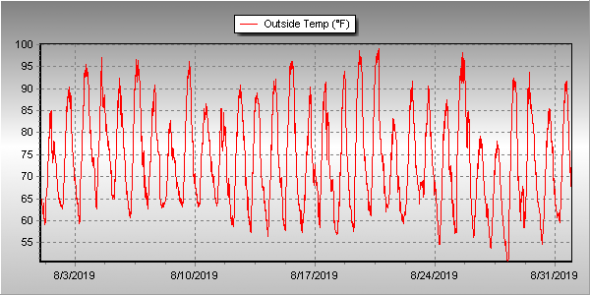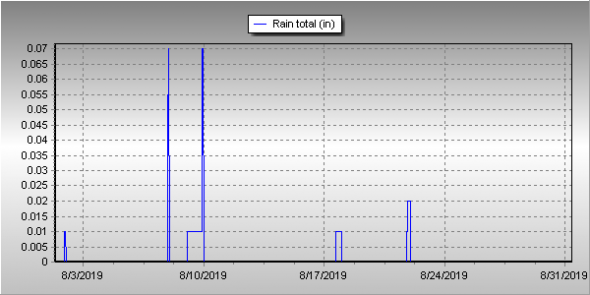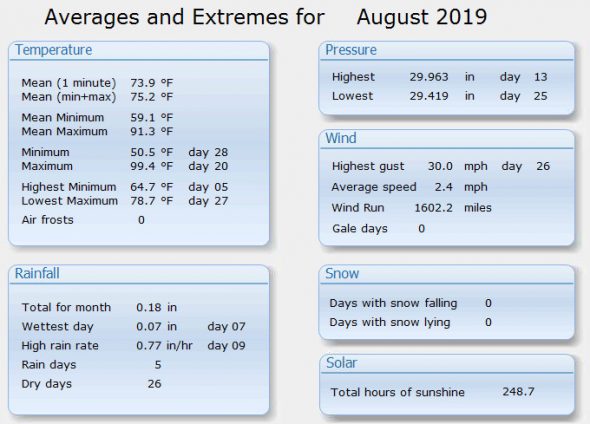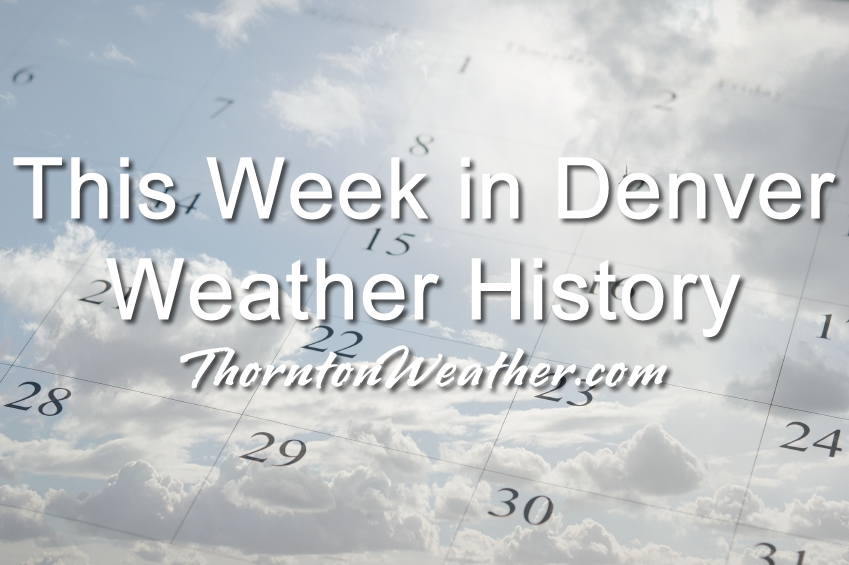
Quite the interesting week in Denver weather history. Swarms of grasshoppers are the most unusual item we see but there is plenty of standard severe weather including tornadoes, landspouts, hail, lightning and much more.
From the National Weather Service:
19-30
In 1875…grasshoppers appeared in great numbers at 10:00 am on the 19th. Thousands landed on the ground. The streets were literally covered with them. Swarms of grasshoppers were seen on each day. All gardens in the city were devastated…and in the countryside the grasshoppers were very destructive to ripened grain. On the 30th the grasshoppers were so numerous as to almost darken the sun.
22-24
In 1987…some locations in metro Denver had a total 3-day rainfall of 2 to 4 inches. Rainfall totaled 0.96 inch at Stapleton International Airport.
23
In 1900…northwest winds were sustained to 42 mph with gusts to 49 mph.
In 1921…a thunderstorm cloudburst produced 2.20 inches of rainfall in an hour over downtown Denver. This is the greatest 1 hour rainfall on record at the official observing site in the city. Precipitation totaled 2.93 inches…which is the greatest calendar day precipitation ever recorded in august.
In 1941…one man was killed by lightning about 2 miles from the official weather station in downtown Denver.
In 1962…a home near Boulder was destroyed by a lightning- caused fire.
In 1968…strong winds buffeted Boulder briefly during the early morning hours. At the National Center for Atmospheric Research…winds averaged 55 mph with gusts to 85 mph. Damage was minor. Northwest winds gusted to 31 mph at Stapleton International Airport.
In 1977…lightning damaged at least 6 homes in Aurora.
In 2008…a landspout touched down near Westcreek in Douglas County. One man was seriously injured when he tried to escaped several falling trees in his ATV. One of the trees struck his back and broke two vertebra. Another camper narrowly escaped injury. Seconds after he back up his truck…a tree came down where it had been parked.
24
In 1880…a thunderstorm produced vivid lightning and heavy rainfall…which caused flooding over the eastern part of the city including the brick yards. There was no rainfall recorded in downtown Denver.
In 1910…an apparent dry cold front caused a remarkable drop in temperature. From 3:00 pm until midnight the temperature fell from a high of 93 degrees to a low of 40 degrees. Northeast winds were sustained to 44 mph during the late afternoon.
In 1946…heavy rain near Idledale caused flooding on Bear Creek at Morrison…which resulted in one death when a woman was swept from her stranded car and drowned.
In 1973…strong winds blew down a few power lines and hail up to 3/4 inch diameter fell in southeast Aurora.
In 1984…heavy rain hit the south Denver area. Over an inch fell in less than an hour at both Castle Rock and Sedalia.
In 1992…heavy rains caused flash flooding across parts of metro Denver. Rainfall amounts of 1 to 3 inches fell with the hardest hit areas being the southwest and central parts of metro Denver. Bear Creek rose above bankfull near Idledale with flood waters moving into southwest metro Denver. Mud and rock slides along Colorado highway 74 west of Morrison were reported. The confluence of Cherry Creek and the South Platte River in downtown Denver also went out of its banks…flooding bike paths. Rainfall totaled 1.98 inches at Stapleton International Airport where light to moderate rain fell most of the day. Heavy rain and fog briefly reduced the surface visibility to 1 1/2 miles. The temperature climbed to a high of only 58 degrees…which was a record low maximum for the date.
In 2002…hail to 7/8 inch in diameter was measured in southwest Denver.
In 2008…several landspout tornadoes developed along a boundary to the southeast of the Denver metropolitan area during the democratic national convention. In northwest Elbert County… Minor damage was reported. The damage consisted of downed power lines…broken windows and an out building. Severe thunderstorms also produced very heavy rain and large hail… Up to one inch in diameter. In southwest Douglas County… Heavy rain caused flash flooding near the town of Westcreek. A mudslide closed State Highway 67. The road in the YMCA camp shady brook was also washed out and some bridges were damaged.
24-26
In 1910…the lowest temperature ever recorded in August…40 degrees…occurred on each of these days and on August 22… 1904. The unusually cold weather for so early in the season brought sub-freezing minimum temperatures to much of the Colorado northeastern plains.
25
In 1951…a microburst produced a southwest wind gust to 50 mph at Stapleton Airport. Only a trace of rain was observed.
In 1964…thunderstorm winds gusted to 59 mph and caused some blowing dust at Stapleton International Airport.
In 1994…lightning struck a power pole in Louisville and caused a two-hour power outage.
In 2008…an unoccupied home was struck by lightning in Aurora… Causing 75 thousand dollars in damage to the roof.
26
In 1944…one of the most destructive hailstorms in the city in a decade caused damage estimated at nearly one million dollars. The storm occurred within a period of 10 to 30 minutes…between 2:00 pm and 3:00 pm. The hail varied in size from very small to as large as 1 1/2 inches in diameter. Hail covered the ground to a depth of 5 to 6 inches in some sections of the city. Several people were cut by broken glass. The hail and heavy rain flooded underpasses to a depth of 6 feet…and the occupants of stalled autos had to be rescued. Sewers were unable to handle the sudden amount of water and water backed up and flooded a number of basements. A few first floors of buildings were flooded. The water department had a busy time replacing manhole covers that had been displaced by the water pressure. Trees were stripped…one was severely broken…and telephone lines were downed. Roofs…windows… Automobiles…awnings…and gardens were severely damaged. Flowers and gardens in some sections of the city were a total loss. Greenhouses were extensively broken with an estimated 20 carloads of glass shattered. Vegetable and truck crops in and around the city were severely shredded. The next day the American Red Cross was designated by the War Agency to grant any and all priorities needed to obtain materials and supplies to replace and repair the damage. In downtown Denver…the thunderstorm produced 0.95 inch of rain and heavy hail along with sustained northwest winds to 25 mph.
In 1961…strong winds blew in the walls of a warehouse under construction in Denver. Two workmen suffered a fractured foot and body bruises.
In 2014…two men in central Denver were struck by lightning as they sat under a tree to avoid a heavy downpour. One of the men was unconscious and had no pulse when emergency responders arrived. He was immediately taken to Denver Health was listed in critical condition. The other victim suffered less severe injuries. He was treated at the scene and hospitalized…then released a few hours later.
26-27
In 1980…two heavy thunderstorms hit Arvada and Westminster… Dumping up to 1.50 inches of rain in less than an hour. At least two streets were washed out and a number of homes and cars were damaged when a creek flooded. Three homes in Arvada sustained minor lightning damage.
27
In 1910…a thunderstorm produced south winds sustained to 40 mph.
In 1961…strong thunderstorm winds and heavy rain occurred at 79th and Federal Blvd. In Westminster. The strong winds blew the roofs off lumber sheds onto parked cars.
In 1967…a young woman was killed by lightning while horseback riding in the suburbs just west of Denver. Her horse died several hours after the incident. A young man and another young woman were also knocked from their horses by the impact of the lightning and required hospitalization.
In 1991…heavy thunderstorm rainfall totaled 0.91 inch at Stapleton International Airport…where 1/4 inch diameter hail was measured.
In 1996…localized street flooding occurred in the Fort Lupton area when 2 to 3 inches of rain fell in 45 minutes. The roof of a community college began leaking…which caused damage to ceiling tiles. The roof was under repair from hail damage which had occurred earlier in the summer. A weak tornado (f0) was sighted near Fort Lupton. No damage was reported.
In 1999…a slow moving thunderstorm dumped 5 inches of rain in 2 hours near Dacono. A severe thunderstorm produced 3/4 inch diameter hail in Castle Rock.
In 2002…severe thunderstorms spread large hail over metro Denver. Hail as large as 2 inches in diameter fell in Jefferson County 5 to 11 miles northwest of Golden. Other large hail reports included: 1 1/2 inches near Golden and in Lakewood; 1 1/4 inches in Nederland; 1 inch hail near Elizabeth…Louviers…Rollinsville…and Blackhawk; 7/8 inch hail near Acequia in Douglas County. A thunderstorm produced a trace of rain and a microburst wind gust to 52 mph at Denver International Airport.
In 2003…lightning struck a house and sparked a fire in Arvada. Damage to the roof and ceiling was extensive.
In 2005…lightning struck an unoccupied home in Parker. The resulting fire damaged the roof…attic…and second floor bedroom. Damage was estimated at 15 thousand dollars.
27-28
In 2004…a brief chilly spell resulted in three temperature records. The high temperature of 55 degrees on the 27th was a record low maximum for the date. The low temperature of 48 degrees on the 27th equaled the record minimum for the date. The low temperature of 42 degrees on the 28th was a record minimum for the date.
28
In 1887…a dry thunderstorm produced north winds to 48 mph but only a trace of rainfall.
In 1968…one man was seriously injured by lightning while riding on a roller coaster at a Denver amusement park. An airline employee was injured when lightning struck a jetliner he was servicing at Stapleton International Airport. A lightning-caused fire did extensive damage to one house and minor damage to several others in the city of Denver.
In 1970…a microburst wind gust to 53 mph was recorded at Stapleton International Airport.
In 2002…a severe thunderstorm produced 3/4 inch diameter hail near Parker.
In 2005…lightning sparked a small fire near Jamestown. The blaze was quickly contained and consumed less than an acre.
29
In 1876…after the passage of a gentle rain shower to the east during the late evening hours…the moon shone brightly and a remarkably bright lunar rainbow appeared.
In 1910…an apparent cold front produced sustained northeast winds to 40 mph.
In 1946…the high temperature warmed to only 55 degrees…the record low maximum for the month.
In 1989…a spectacular lightning display knocked out power to 300 blocks in southeast Denver. One bolt started a fire in a lumber yard in the northeast part of the city…and the attic of a home in the same area was set ablaze by a lightning bolt.
In 1996…3/4 inch diameter hail was measured in Parker.
In 2000…lightning struck two homes in Thornton. The extent of damage was unknown.
In 2002…two small tornadoes caused damage in southeast metro Denver. The first tornado…associated with a multi-vortex storm…touched down briefly near E-470 and South Jordan Road. Some fences were damaged…and a few trees were blown down. A few of the homes also sustained minor roof damage. Damage from this storm totaled 100 thousand dollars. The second tornado associated with the storm touched down in a subdivision that was under construction at Gartrell and Arapahoe roads. Four large condominiums under construction were destroyed. The most heavily damaged portions of the structures were still in the framing stages. Adjacent sections where enclosed walls were in place were not destroyed. A man suffered 4 broken ribs and several cuts and bruises when the trailer he sought shelter in was flipped three times and torn apart by the twister. Damage from this storm totaled 6 million dollars. A severe thunderstorm produced 1 inch diameter hail near Evergreen.
In 2006…severe thunderstorms produced large hail in the foothills west of Denver. Hail to 1 inch in diameter fell near Blackhawk. Hail as large as 7/8 inch was measured near Idaho Springs…along with 3/4 inch hail near Nederland and Conifer.






